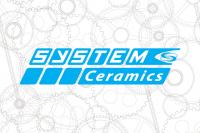
The Lamgea mouldless press technology for the production of large ceramic tiles and slabs is extremely uniform, meaning that fired products have constant density and a high degree of homogeneity after firing to create the so-called “book match” effect.
The production process for large ceramic tiles and slabs developed by System Ceramics centres around Lamgea mouldless press technology.
Lamgea has a dedicated work cycle capable of producing large-size slabs (up to 1800x4800 mm) in a wide range of thicknesses (from 3 to 30 mm).
This pressing system is a unique technology for several reasons. In particular, it is extremely uniform, meaning that fired products have constant density and a high degree of homogeneity after firing to create the so-called “book match” effect.
Lamgea28000 (size up to 1800x2700 mm) and Lamgea25000 (size up to 1800x2400 mm) can produce sub-sizes based on 60 mm, 80 mm and 90 mm modules, guaranteeing the high productivity and quality that have always been hallmarks of System Ceramics. Thanks to the absence of a mould, the press also allows for maximum flexibility in size change operations, which involve setting a number of parameters digitally via software without the need for mechanical operations or belt changes. But the really unique feature of this pressing technology is the fact that all the sizes can be produced with a single belt, thereby considerably reducing costs.
Compared to traditional large-size tile pressing, the System Ceramics forming process guarantees a flatness to within 0.1 mm and a calibre of 2 mm or less per side. This means that less material needs to be removed during the rectification and semi-polishing operations, considerably reducing processing costs. In keeping with principles of lean manufacturing and industrial sustainability, the System Ceramics technology also facilitates the task of recovering scrap from the pressing and cutting stages. The recycled scrap is processed directly alongside the press and is then mixed and batched ready to be introduced directly into the feeders. This avoids having to transport the material recovered from the pressing and cutting process inside the factory.
Did you find this article useful?
Join the CWW community to receive the most important news from the global ceramic industry every two weeks





















